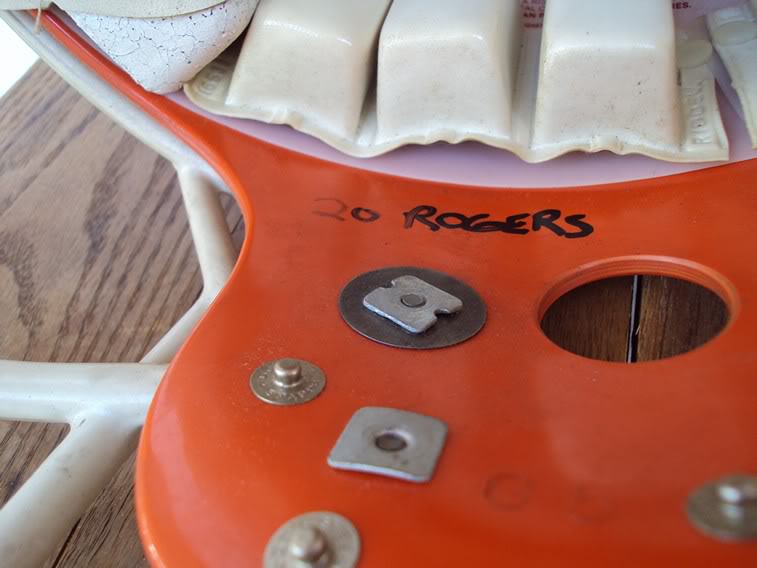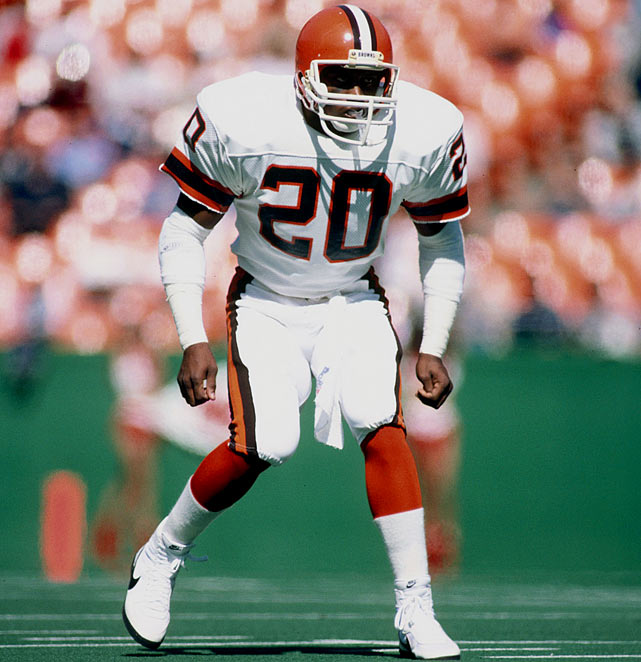 This is one installment in a team effort by The Cleveland Fan, highlighting the top local sports figures by jersey number. Please weigh in with your thoughts, in the Boards. As David Letterman would say, “For entertainment purposes only; please, no wagering.”
This is one installment in a team effort by The Cleveland Fan, highlighting the top local sports figures by jersey number. Please weigh in with your thoughts, in the Boards. As David Letterman would say, “For entertainment purposes only; please, no wagering.”
“Hey Greg, were Hanford Dixon and Frank Minnifield really as good as everyone says?”
My inquisitor was an NFL fan- but of a non-Cleveland stripe, and of a younger generation. This was an important question, and it required the emphasis of understatement. I nodded.
“Oh, yeah.”
I mentioned “Night Train” Lane and Dick LeBeau of the early 1960s Detroit Lions. Deion Sanders and Larry Brown of the 1995 Dallas Cowboys. Sam Madison and Patrick Surtain of the early 2000s Miami Dolphins.
“You could make a case for Lester Hayes and Michael Haynes of the 1980s Oakland Raiders. They probably are the best tandem in NFL history- at least, they won a Super Bowl. Of course, many maintain that the Prevent Defense Marty Schottenheimer employed against Denver was the reason the Browns didn’t reach the Super Bowl in the ‘80s. Nobody blames Top Dawg and Mighty Minnie.
So yeah, Dixon and Minnifield were among the best corners in NFL history.”
Later that day, I flipped my friend this link.
I suspect this “Top Figures” series will have plenty to say about the iconic duo. Dixon, the first round draft pick with the oversized hand towel swaying from his 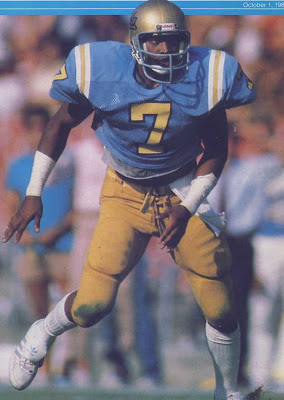 belt, and Minnifield, the fearless USFL refugee who was short in stature but not in strength of will.
belt, and Minnifield, the fearless USFL refugee who was short in stature but not in strength of will.
In his Day of the Dawg book, Hanford Dixon discusses this at length. He also notes the immediate impact of another defensive back acquired for that 1984 season, the one that saw the Browns’ debut of Minnifield. Number 20.
***
The player side of Don Rogers was aggression personified. He began leading the UCLA Bruins defense from his safety position as a sophomore. By the time he graduated, he was a unanimous All-American, a can’t-miss star in the pros. Browns coach Sam Rutigliano was sold: Rogers was the one he wanted to select with their first pick in the NFL draft.
The United States Football League was still in operation, however, and the San Antonio Gunslingers drafted him as well. They traded his signing rights to the Arizona Wranglers. Dixon reveals that Browns coach and former running back Calvin Hill (basketball star Grant Hill’s father) wined and dined Rogers, convincing him to sign with Cleveland.
Rogers had an immediate impact with the Browns. He warmed up to the barking of the other DBs and the Dawg Pound. It was almost like having two players in his #20 jersey. From his safety position, he provided strong pass coverage, but he also plugged running lanes at the line of scrimmage. He hit like a linebacker, too. To the rest of the National Football League, having to face Dixon, Minnifield, and Don Rogers was just scary.
The Browns had high expectations in 1984, but suffered a down season. The offense struggled with Paul McDonald at quarterback. Rutigliano, once celebrated locally for his gambling mindset on offense, had several decisions backfire. The team was also beset by injuries. He was fired by Art Modell after a 1-7 start. Marty Schottenheimer, the defensive coordinator for the Browns since 1980, was Rutigliano’s replacement.
1985 was the year quarterback Bernie Kosar was selected by the Browns in the supplemental draft. Veteran Gary Danielson was brought in to start, and to 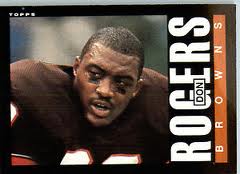 tutor the rookie. Danielson got hurt a few games into the season, and Kosar became the man. Offensive coordinator Lindy Infante also had come to Cleveland from his USFL post, and his vertical offense suited the young quarterback. Kosar quickly internalized Infante’s pre- and post- snap read philosophy. Supported by the great running back tandem of Kevin Mack and Earnest Byner, the offense rebounded from the prior season.
tutor the rookie. Danielson got hurt a few games into the season, and Kosar became the man. Offensive coordinator Lindy Infante also had come to Cleveland from his USFL post, and his vertical offense suited the young quarterback. Kosar quickly internalized Infante’s pre- and post- snap read philosophy. Supported by the great running back tandem of Kevin Mack and Earnest Byner, the offense rebounded from the prior season.
The Browns defense was beginning to come of age in 1985, as well. And one of the standout players was safety Don Rogers.
In the summer of 1986, Rogers had a week to go before his wedding day when the tragic news of the death of Lenny Bias shocked the sports world. The star forward out of Maryland had just been chosen in the first round of the NBA draft by the powerful Boston Celtics, and a terrific future was all but assured for him. It was gone in the blink of an eye, however; he had succumbed to a cocaine overdose. (Cocaine was the party drug of choice for those who could afford it.)
Dixon and others paint the picture of the other side of Don Rogers, the personal side. He was quiet, a follower. He wanted others to like him, and others influenced the decisions he made. This made it highly important that he hung around people of good character. Unfortunately, as Dixon relates, Rogers did 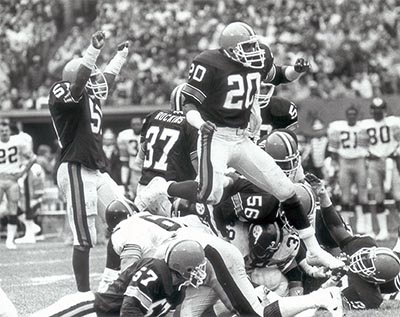 hang with a bad element- especially once he reached the pros. Rutigliano insisted that the Browns had thoroughly researched Rogers’ lifestyle prior to drafting him, and said he was not involved in drug use at that time. This is contradicted by other sources.
hang with a bad element- especially once he reached the pros. Rutigliano insisted that the Browns had thoroughly researched Rogers’ lifestyle prior to drafting him, and said he was not involved in drug use at that time. This is contradicted by other sources.
By the time Rogers’ bachelor party had arrived, Hanford Dixon was like Rogers’ big brother on the Browns. To this day, he remains tormented by his role in the decisions he knew Rogers was going to make the night of the party. Dixon’s account is that Rogers had been a cocaine user, and was leaving the party to have his last big blowout before getting married. He maintains that he passed up his one chance to stop Rogers from going on his final, reckless binge. Outsiders may find Dixon’s take to be unfair to himself, but he is adamant. (Chapter Eight of his book is titled, "I am Responsible for Donnie Rogers' Death.")
The death of Don Rogers, coming so soon after the lesson of Len Bias, was hard to take for everyone who knew him, but it hit his extended family especially hard. They had come to rely on him for support- financial and otherwise. He had been responding faithfully to extreme pressure at home, all the while holding his troubles inside.
When Rogers' autopsy was reported, his mother suffered a heart attack. The findings were that he had died of a massive cocaine overdose. For a time, she remained in denial. However, there were no signs of extended use.
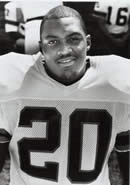 Dixon points out that things eventually turned out badly for Don Rogers’ mother, brother and sister. There is no specific word on the long-term effects on his fiancé, or his then-four year old son. The cost to the Cleveland Browns is lamented (Dixon and Minnifield... and Rogers? Shoot…). But put into the proper context, it’s really most importantly about the kid.
Dixon points out that things eventually turned out badly for Don Rogers’ mother, brother and sister. There is no specific word on the long-term effects on his fiancé, or his then-four year old son. The cost to the Cleveland Browns is lamented (Dixon and Minnifield... and Rogers? Shoot…). But put into the proper context, it’s really most importantly about the kid.
***
You know how when you’re having a typically choppy day at the golf course? And you hit that great draw above the trees that runs up and over the lip of the green and settles within three feet of the cup?
Well, me either, but that would be really great. Moments like create devotees out of thousands of duffers. To me, a nugget of humor in an article I am writing is like that. Dave Barry was my original role model. Of course, as my wife first told me 25 years ago, I must be careful: sometimes I am the only one to think something is funny. (THAT is hilarious.) So be it- but those nuggets are my ‘juice’. They keep me locked in.
The Don Rogers story is not humorous. For that reason, I have avoided the subject. It is a tragic tale from any perspective- especially through the eyes of his son. Sometimes, the hope and wish of one-time U.S. Speaker of the House of Representatives Tip O’Neill is not reality: sports cannot always be a refuge from the rigors of daily life.
But it was an honor to take the baton for #20 on The Cleveland Fan’s Top Sports Figures. Because a guy like Don Rogers needs to be remembered, for all our sakes.
